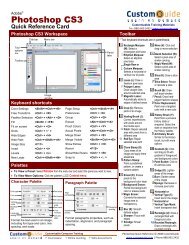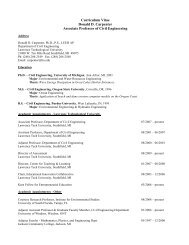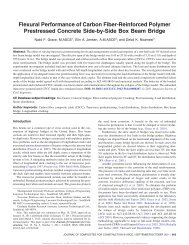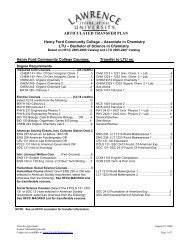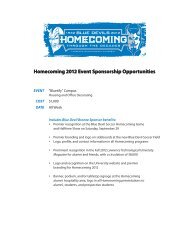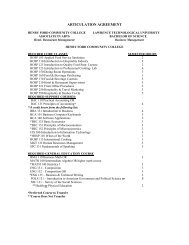Rain Garden Design, Construction & Maintenance - Lawrence ...
Rain Garden Design, Construction & Maintenance - Lawrence ...
Rain Garden Design, Construction & Maintenance - Lawrence ...
- No tags were found...
You also want an ePaper? Increase the reach of your titles
YUMPU automatically turns print PDFs into web optimized ePapers that Google loves.
<strong>Rain</strong> <strong>Garden</strong> <strong>Design</strong>,<strong>Construction</strong> &<strong>Maintenance</strong>Donald Carpenter, Ph.D.<strong>Lawrence</strong> Technological UniversityANLA Management ClinicFebruary 9, 2009Louisville, KYOverview• What is a rain garden?• Why have a rain garden?• How do rain gardens work?• What are the soil characteristics of plantingmixture design?• How do I design a rain garden?• Where should I locate my rain garden?• What maintenance does a rain garden need?1
What is a <strong>Rain</strong> <strong>Garden</strong>?What is a <strong>Rain</strong> <strong>Garden</strong>?© State of Minnesota Stormwater Manual2
<strong>Rain</strong> <strong>Garden</strong> orBioretention CellPlantsBufferBufferPlantsPlanting MixPondingUnderdrain (optional)MulchAdditional Storage (optional)In-situ soils<strong>Rain</strong> <strong>Garden</strong>sLathrup Village, MICourtesy of Lillian Dean3
BioretentionCellsWhy have a <strong>Rain</strong><strong>Garden</strong>?4
Hydrologic Cyclehttp://www.nrcs.usda.gov/technical/stream_restoration/scrhimage.htmPollutants in Urban Runoff• Sediment• Nutrients (phosphorus and nitrogen)• Heavy Metals• Pesticides/herbicides• Bacteria/pathogens• Hydrocarbons (oils/gasoline/grease)5
<strong>Rain</strong> <strong>Garden</strong>s - Benefits• Key feature for LID/conservation design• Focus on water quality volume – know as firstflush (first ½” to 1” 1 of rainfall) & represents90% of all rainfall events• Filter and removal mechanism - removesediments (85%), nutrients (50% - 80%) ,metals (95%), and hydrocarbons (80%)• Stormwater master plan => rain gardens canhave tremendous impact on a watershed<strong>Rain</strong> <strong>Garden</strong>s – Benefits• Improved natural habitat & biodiversity• Less drug depended turf grass to mow(reduces carbon emission – global warming)• Landscaping improves property values• Joy of gardening6
How do <strong>Rain</strong> <strong>Garden</strong>swork?How do <strong>Rain</strong> <strong>Garden</strong>s work?• <strong>Rain</strong> <strong>Garden</strong>s capture and filter stormwater• Numerous physical and biological processesincluding evapotranspiration, , adsorption,filtration, plant uptake, microbial activity,decomposition, and volatilization• Planting mix comprised of sand, topsoil, andcompost – topped with mulch7
How do <strong>Rain</strong> <strong>Garden</strong>s work?• Mulch• Filter pollutants & microorganism degradehydrocarbons• Protects planting mix from eroding and holdsmoisture in during dry season• Planting Mix• Absorbs and degrades pollutants• Clay specifically good at absorbing hydrocarbonsand heavy metals• Sand improves drainage• Compost provides nutrients and increasesretentionHow much sand,topsoil, or compostshould I use?8
<strong>Rain</strong> <strong>Garden</strong> Mix <strong>Design</strong>s• Numerous recommended mix designs have beenpublished (17 states & 2 others)• For new community developments mix designs mightbe specified by municipality• Example Mix <strong>Design</strong>s:• 50% sand, 30% topsoil, 20% compost• 20 – 40% sand & 60 – 80% compost• NRCS Soil Triangle (Loamy Sandto Sandy Loam)<strong>Rain</strong> <strong>Garden</strong> Mix <strong>Design</strong>s• Numerous recommended mix designs have beenpublished (17 states & 7 others)• For new community developments mix designs mightbe specified by municipality• Example Mix <strong>Design</strong>s:• 50% sand, 30% topsoil, 20% compost• 20 – 40% sand & 60 – 80% compost (SOCWA)• NRCS Soil Triangle (Loamy Sand to Sandy Loam)• 0% to 25% clay; 1.5% to 25% organic content, 5.5to 6.5 pH• Balance sand & compost based on your specific siteand native soils9
How do I design a <strong>Rain</strong><strong>Garden</strong>?Observation or Quantitative10
<strong>Rain</strong> <strong>Garden</strong> Infiltration• Infiltration of native soils is key for performance• Need native soil information for proper design• HSG maps (soil type A (1 to 3 in/hr); B (0.5 in/hr); C(0.2 in/hr); D (< 0.1 in/hr)• Home test• 18” hole – fill with water; drain, refill and record• Infiltration rate ( (i ) = rate fall/time = inches/hour• If original fill takes more than 48 hours = clay• Key is infiltration at “bottom” of the rain garden<strong>Rain</strong> <strong>Garden</strong> Infiltration• Improve infiltration by tilling or ripping• i > 0.5 in/hr then basic rain garden design• i < 0.5 in/hr => underdrain or overflow• Above seasonalwater table11
<strong>Rain</strong> <strong>Garden</strong> Sizing• Total area flowing into a rain garden shouldbe less than 1 ac total and ½ acre impervious• Minimum rain garden dimensions arecommonly 10 ft by 20 ft• any size will work as a landscaping feature• Recommended planting mix depth is 2.5 ft (1ft to 4 ft)• Ponding depth is typically 6” 6 to 18”• Recommend 24 to 48 hours to drain (< 72hours)<strong>Rain</strong> <strong>Garden</strong> Sizing Techniques• Homeowner How-to Manuals availablefrom U of Wisc. . Ext., VA Dept ofForestry, & SOCWA (handout)• Numerical <strong>Design</strong> Techniques• Run-off Method• Simplified Darcy’s s Law12
<strong>Rain</strong> <strong>Garden</strong> <strong>Design</strong>Run-off Method• Developed in the Mid-Atlantic• Assumptions• 1” of rainfall will be capture• 2.5 ft and 4ft of planting depth with 50/30/20 mix• 6” ponding with 48 hour drainage time• Doesn’t t consider native soilsSA = 0.07∗C ∗ DA + C DACC= runoffDA = drainage area ( ft( )2SA = surface area of filter bed ( rain garden)(ft )impgreen=impimpcoefficient ofrunoff coefficient of2)greengreenimpervious surfaces = 0.9green areas = 0.25<strong>Rain</strong> <strong>Garden</strong> <strong>Design</strong>Simplified Darcy’s s Law• Simplified by Dr. Carpenter• Assumptions• 1” of rainfall will be capture (90% of all rain events)• Excess rainfall should be bypassed• Well maintained rain garden with mix ofcompost/sand• 48 hour drainage time• Includes infiltration rate of native soils13
<strong>Rain</strong> <strong>Garden</strong> <strong>Design</strong>Simplified Darcy’s s Law0.04×c×DA×depthSA =( i)×( depth + ponding)SA = surface area of rain garden(ftDA = drainage area ( ft)depth = planting bed depth(ft)i = infiltration rate(ft / day)c = runoff coefficient ( between0.1and0.9)ponding = average ponding depth(ft)0.1 0.3 0.5 0.7 0.92)NativeLawnPatioRunoff coefficient spectrumRoof/DriveBioretention Cell<strong>Design</strong> ExampleDA 114
<strong>Rain</strong> <strong>Garden</strong> SizingComparison• 1000 sq ft of roof (all impervious)• 2.5 ft of planting depth & 0.5 ft ponding• Sand (1.0 ft/day) & Clay (0.2 ft/day)SandClaySimplifiedDarcy’s30 sq ft150 sq ftRun-off63 sq ft63 sq ftWhere should I locatemy <strong>Rain</strong> <strong>Garden</strong>?16
<strong>Rain</strong> <strong>Garden</strong> <strong>Design</strong>Location & Landscaping• Observe natural flow paths• Direct water from down spouts and pavementinto the garden• Create berms with overflows• Not within 10 ft of building foundation• Avoid underground utilities!• Avoid disturbing mature trees & drip zones• Avoid areas of standing water<strong>Rain</strong> <strong>Garden</strong> <strong>Design</strong>Location & Landscaping• Limit erosive velocities enter garden• Site slopes (min 10H:1V – max 3H:1V)• Buffer zones to limit fines and reducevelocities (rock, grass, etc.)• Multiple smaller gardens might be moreeffective than one larger garden especially inclay soils• Proper landscaping and plant choice isessential• 2” to 3” 3 of aged hardwood mulch (max!)17
What maintenance doesa rain garden need?<strong>Rain</strong> <strong>Garden</strong> <strong>Maintenance</strong>• Regular <strong>Maintenance</strong>• Weeding, watering• Cutting, pruning, and removing• Replace and replant• V-notch edge• 2” to 3” 3 of aged hardwood mulch (as needed)18
Field InfiltrationMeasurementsReferences & Resources• <strong>Lawrence</strong> Tech University Stormwater Pagehttp://www.ltu.edu/stormwater.html• SOCWA Healthy Lawns and <strong>Garden</strong>s -http://www.socwa.org/lawn_and_garden.htm• <strong>Rain</strong> <strong>Garden</strong>s of West Michigan -http://www.raingardens.org/Index.php• Virginia Department of Forestry – <strong>Rain</strong> <strong>Garden</strong>s Technical Guidehttp://www.dof.virginia.gov• Minnesota Stormwater Manualhttp://www.pca.state.mn.us/water/stormwater/stormwater-manual.html• Low Impact Development Manual for Michiganhttp://www.semcog.org/lowimpactdevelopmentreference.aspx• Center for Watershed Protectionhttp://www.cwp.org19
Questions?Contact InformationDonald D. Carpenter, Ph.D.Associate Professor of Civil Engineering<strong>Lawrence</strong> Technological University21000 W. Ten Mile RoadSouthfield, MI 48075Office (248) 204-2549Cell (248) 763-4099Fax (248) 204-2568carpenter@ltu.edu20



